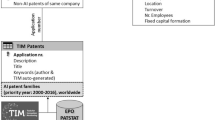Abstract
Patent activity in China for vibration-reduction control technology in high-speed railway vehicle systems was analyzed based on a portfolio of 193 patents or applications from the State Intellectual Property Office of the People’s Republic of China official Web-based database and a search of the World Intellectual Property Organization PCT database. Patent activity features such as timing, applicant, technology classification, technical themes, and patents in force were obtained and analyzed. As a further stage of research, patent data on locomotive wheel sets were analyzed by means of a matrix analysis of problems and technologies. The main statistical information and conclusions include estimating the development stage, discovering the distributions of applications and applicants, weighing the roles played by major applications, determining R&D hotspots, and providing a better understanding of domestic patent activities in this field. Policy implications for innovation-related domestic R&D institutions in the technologies under study were proposed based on the analytical results.










Similar content being viewed by others
Notes
State Intellectual Property Office of People’s Republic of China. Available from http://www.sipo.gov.cn/zljs/.
Data including published patent documents from Apr.1st 1985 to Feb. 5th 2011 as the unpublished patent or confidential patent documents are excluded.
For the reason of deferred examination of patent application, the number of published application in year of 2009 is a partial file of the year.
The national average cited in the paper was calculated based on data from SIPO Annual Reports unless otherwise stated.
Section B: Performing operations; transporting.
In accordance with the patent law of China, an institution or an individual may file a patent application.
The Article 20, Paragraph 1 of Patent law of the People's Republic of China, 2000.
In accordance PCT, the applicant in an international application under PCT fulfill the requirements of entering the Nation Phase within 32 months of the earliest priority date if the application is planned to be grant by a specific authority.
References
Connie, Wu, & Liu, Yanhuai. (2004). Use of the IPC and various retrieval systems to research patent activities of US organizations in the People’s Republic of China. World Patent Information, 26(3), 225–233.
Elisabeth F. (2011). China’s High-Speed Rail Revolution. Railway-technology.com. Accessed July 21, 2011 from http://www.railway-technology.com/features/feature124824/.
Japan Patent Office, Asia-Pacific Industrial Property Center, JIII. (2006). Guide book for practical use of ‘patent map for each technology field’. Accessed Sept. 4, 2006 from http://www.okpatents.com/phosita/images/patent_map_JPO.pdf.
Li, M. X. (2012). 2011 Annual report of Chinese patents in force. Science Focus, 7(5), 1–30.
McCain, K. W. (1990). Mapping authors in intellectual space: A technical overview. Journal of the American Society for Information Science, 41(6), 433–443.
Shen Y. X. (2011). MOR responds mixing up functions of government & enterprises: Stage specificity. Accessed Feb. 20, 2011 from http://society.people.com.cn/GB/86800/14588444.html.
UIC. (2010). General definitions of high speed. International Union of Railways. Accessed March 12, 2012 from http://www.uic.org/spip.php?article971.
Wu, Y. M. (2009). An empirical analysis of R&D cooperation and regional knowledge spillovers based on knowledge production function. Studies in Science of Science, 27(10), 1486–1494.
Yang Y., Shen Y. X.. (2011). MOR: Overcome technical problems, CSR Filed 1902 Patent Applications. Accessed Feb. 4, 2011 from http://www.cnipr.com/focus/zthc/zggtzscq/gtzx/201101/t20110130_125549.html.
Yu, D. W., & Wang, X. H. (2009). 2008 Annual report of Chinese patents in force. Science Focus, 4(6), 17–25.
Zhang, X., Gao, L. D., Tang, C., et al. (2007). Research and application of the patent map. Journal of Information, 02, 190–193.
Zhang, F., Xiao, G. H., & Zhang, X. (2008). Typical applications of patent map. Science and Technology Management Research, 02, 190–193.
Acknowledgments
I am very grateful to the technical experts and patent agents for providing the technical information and help. Also, I deeply appreciate the financial supports to this research from the Fundamental Research Funds for the Central Universities from Ministry of Education, No. SWJTU09BR276.
Author information
Authors and Affiliations
Corresponding author
Rights and permissions
About this article
Cite this article
Zhang, F., Zhang, X. Patent activity analysis of vibration-reduction control technology in high-speed railway vehicle systems in China. Scientometrics 100, 723–740 (2014). https://doi.org/10.1007/s11192-014-1318-3
Received:
Published:
Issue Date:
DOI: https://doi.org/10.1007/s11192-014-1318-3




